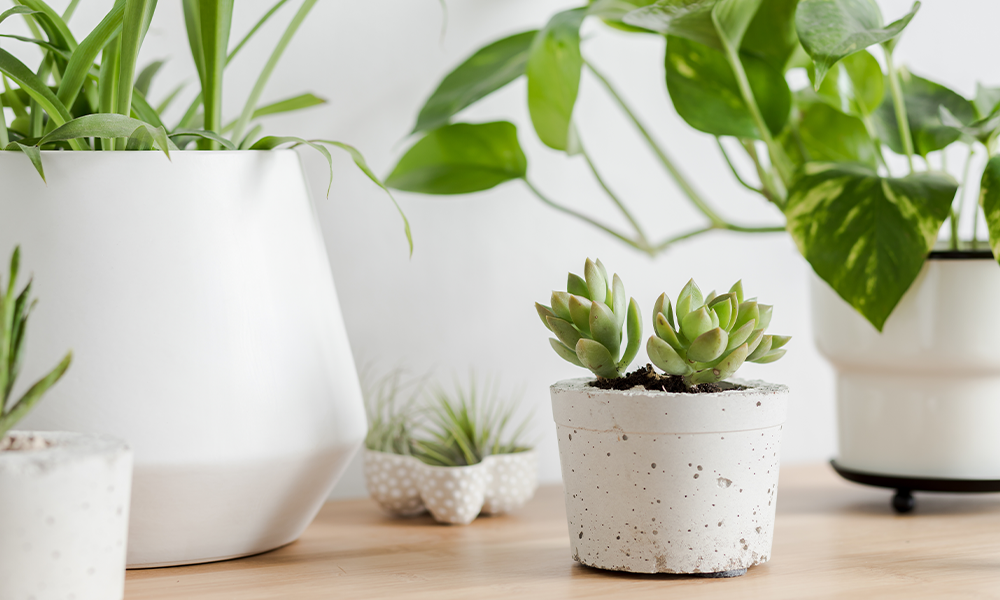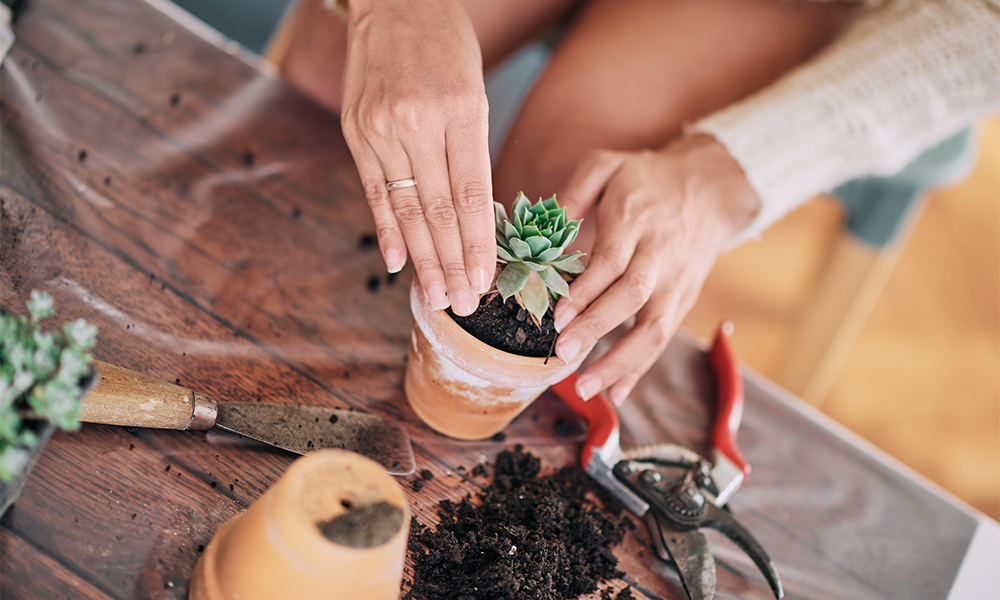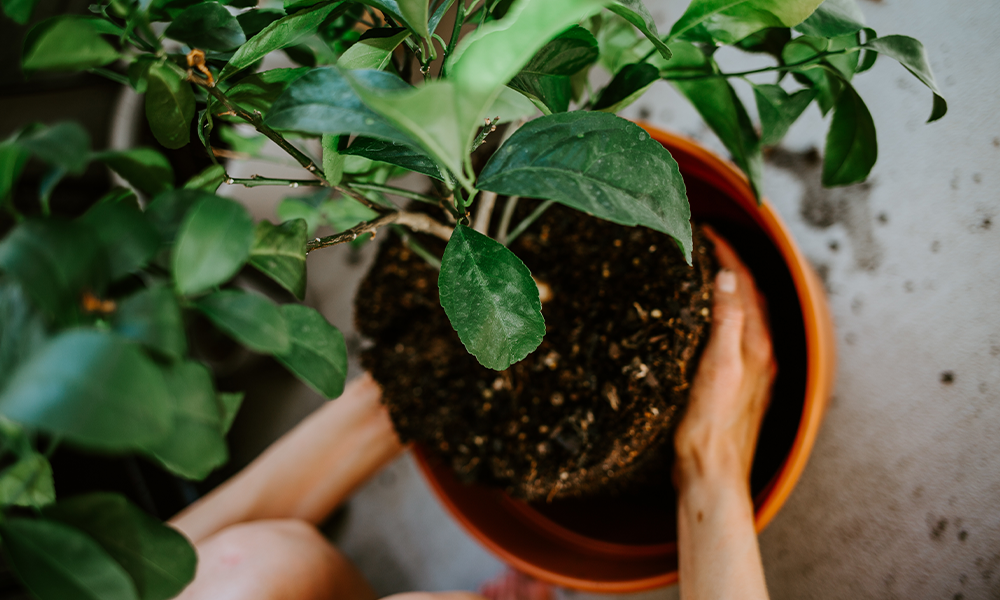Even though we don’t always notice, our potted plants grow more and more every year. Eventually, they’ll outgrow their current container, and will be more comfortable and healthy if you repot them into a new planter. However, out-growing is not the only reason to repot your plants; maybe you want to put them in a more permanent container than the nursery pot, or you want to give your tropical plant a pot with some matching tropical flair. Plus, if your plant has been growing in the same container for several years, the soil is definitely lacking in important nutrients, so it will benefit from being repotted with some fresh soil to replace the old.
Whatever the reason, there are a few important things to remember when you’re repotting your plants.
When to Repot
The main guideline for gauging whether it’s time to repot your plants is if they’ve become root-bound. There are a few ways to check this; if your plant is in a nursery pot inside a decorative pot, you can remove it from the decorative pot and check the drainage holes. If sizable roots are sticking out of the drainage holes, your plant is root-bound and should be sized up into a new home.
If your plant is not in a nursery pot, its a little more difficult. One of the key symptoms is if your plant’s leaves wilt quickly, even if they’ve been watered within 24 hours. Otherwise, you may have to try and remove your plant from its pot to determine if it’s root-bound.
A plant that is only just starting to become root-bound will slide out of a plastic nursery pot quite easily. An extremely root-bound plant, with large roots coming out of the drainage holes, will be much more difficult. You may need to cut the pot away from the plant to get it off!
Choosing a New Pot
It’s so tempting to just run out and buy the first cute pot you see that looks bigger than the one your plant is currently in. Don’t do that. You can definitely buy a cute pot, but it’s important to measure the pot your plant is currently in before you go shopping. Much bigger is not always better—in fact, a huge pot for a relatively small plant is setting you up for trauma. We’re more likely to water large pots more frequently than small pots, and if your plant is too small for the pot, it’s likely to develop root rot from being overwatered.
Measure the diameter of your current pot, and choose a new pot that is only 1-3 inches larger than the current pot. This gives your plant just enough room to grow for another year or two.
Choosing New Soil
When you’re getting ready to repot your plants, it’s important to consider what soil you’re going to use. Many plants are happy in a good quality generic potting soil, but many plants, like orchids, African Violets, cacti, palms, and succulents need specific soil. All of these types of plants need soil that drains very quickly, whereas most other plants will also benefit from soil that drains steadily and retains a bit more moisture.
Most cacti, palms, and succulents will do well in general cactus potting mix. African Violets and orchids will do best in potting mix designed specifically for them. All of these mixes contain plenty of organic material to allow fast drainage, so plants don’t develop deadly root rot. Approximately 70% of orchids are epiphytes, which means in the wild they don’t grow in soil at all. They attach themselves to other plants and trees for support, and they survive off humidity and rainfall. Epiphytic orchids will do best in an orchid mix made from chunks of bark.
The main thing is that it’s important to know what kind of plant you have and to research what type of soil will be best for them.
Repotting Your Plant
Before you repot your plant, make sure you have everything you need; soil, pot, water, and possibly scissors or a knife to remove the old pot. If you’re potting your plant into a different container that you already own, make sure it is clean and sterile before you start.
Water your plant in its current container about an hour before you plan to repot. This should help make it easier to remove. If your plant is on a strict watering schedule, repot them on the day you would normally water.
Add some new soil to the bottom and sides of your new container. If the new container has large drainage holes, you may want to cover them with some rocks or broken pieces of other pots before you add soil.
Gently remove your plant from its current container. Tip your plant sideways, with one hand holding around the base of the plant against the soil, then tap the bottom of the pot, or lightly squeeze around the pot with your free hand to loosen it. Try to pull the pot off the plant, rather than pull the plant out of the pot. If it doesn’t come off easily, you may need to slip a knife in right against the inside of the pot to loosen it or cut the pot off its plastic nursery pot. If you’re repotting a large plant, like a hibiscus tree, you’ll need help for the repotting process.
If your plant is slightly root-bound, loosen the roots up and tease them out so they’re not stuck in the shape of the pot. If it’s really tightly root-bound, you may need to use a knife and cut through some of the roots to loosen things up. Don’t feel bad if you break some roots, this will help stimulate new growth when the plant is in its new home.
Set your plant into its new pot, and add soil around the edges and the top while supporting it with one hand. Pack the soil around the roots firmly so it will be well supported. Leave a good inch of room between the top edge of the pot and the top of the soil so you have room to water without spilling over the edges.
The last step is to give your plant some water in its new pot, and then let it rest. Repotting is a bit stressful for your plant, so if it usually sits in some bright sun, let it rest in a shady spot for at least 24 hours before you return it to its normal spot. Plants that normally sit in a shady spot can be returned to their normal place as soon as you’re finished. Your plant should quickly take to its new container, and before long, your leafy pal will be growing bigger and healthier than ever before!




